Two of the most popular SEO tools on the market today are SE Ranking and Semrush.
How do these SEO tools compare? In this SE Ranking vs. Semrush comparison, we examine the features, strengths, and differences of these platforms to help you decide which tool best fits your SEO needs.
BoostPlanner is reader-supported. If you buy through a link on my site, I may earn an affiliate commission.
SE Ranking vs Semrush Overview
SE Ranking and Semrush are two of the most popular all-in-one SEO tools, each offering extensive features for SEO professionals, marketers, and agencies. Semrush, founded in 2008, is well-established with a broader feature set and a large keyword and backlink database. SE Ranking, introduced in 2013, is known for its affordability and flexibility, catering to various user needs without compromising core SEO functionality.
Both platforms provide essential features like keyword research, rank tracking, site audits, competitor analysis, and reporting, but each offers unique capabilities and pricing structures suited to different user types and budgets.
Learn more about the key differences in this Semrush vs SE Ranking comparison. Each major feature is compared in detail to help you choose the right tool for your needs.
Feature Comparison: SE Ranking vs Semrush
This table provides a snapshot of feature differences between SE Ranking vs Semrush:
| Features | SE Ranking | Semrush |
|---|---|---|
| Keyword Research | Keyword research tool includes a huge database of search query data with metrics like search volume and keyword difficulty for SEO & PPC campaigns. | The Keyword Magic Tool offers the largest database of keyword data such as search volume and keyword difficulty for SEO & PPC campaigns. |
| Rank Tracking | Rank tracker with daily, three days, or weekly updates. Track keywords in Google, YouTube, Bing, and Yahoo. | Rank tracker with daily keyword ranking updates. Track keywords in Google's search engine. |
| Competitor Research | Competitor organic traffic trends and analytics, top pages, and keyword rankings. | Competitor organic traffic analytics and trends, top pages, and keyword rankings. |
| Backlink Analysis | Large backlink database. Monitor and audit backlinks for changes such as new and lost links. | Largest backlink database with link audit tools. Monitor backlinks for changes such as new and lost links. Audit link toxicity. |
| Site Auditing | Audit your site for technical errors, issues, and opportunities. | Run site audits to identify technical errors, issues, and opportunities. |
| On-Page SEO | On-page SEO audits and data-driven content optimization tools. | Detailed on-page SEO analysis tool for page-level audits. |
| Local SEO | Granular local rank tracking with street-level grid insights, automated GBP management and scheduling (coming soon), and AI-powered review monitoring | Offers extensive citation management across 150+ directories, Google Maps rank tracking, and AI-generated responses for GBP reviews. |
| Content Marketing | Content marketing tools and editor are offered as add-on features | Content marketing tools are included in the Guru plan |
| AI Writing Assistant | Offers a full-cycle AI-powered content creation tool integrated into its Pro plan. It includes SEO optimization, competitor analysis, content briefs, and Google Docs integration. The AI Writer is included with specific word limits, and additional words can be purchased as an add-on. | Provides an AI Writing Assistant as a separate app developed by Copymatic, requiring an additional $25/month subscription. It specializes in various content types (blogs, ads, emails, social media), plagiarism detection, and multi-language support but lacks built-in competitor analysis and content brief creation tools. |
| Social Media Marketing | Basic social media tracking and GBP scheduling (coming soon) | Includes a social media marketing toolkit with scheduling, tracking, and analytics for platforms like Facebook, Twitter, and Instagram |
| Reporting | White-label report builder | White-label report builder |
| Support | Chat, email, phone | Chat, email, phone |
| API Access | Business plan required | API-specific subscription |
| Fixed Plans | Essential, Pro, Business | Pro, Guru, Enterprise |
| Pricing | Starts at $65/month | Starts at $139.95/month |
| Discount | 20% off with an annual plan | 17% off with an annual plan |
| Free Trial | 14-Day Free Trial | 7-Day Free Trial |
While Semrush provides more features and research data, SE Ranking offers more flexible and affordable plans with many similar core features.
SE Ranking vs Semrush: Key Features
Let’s dive into the key features of these two powerful SEO platforms, first focusing on their keyword research capabilities to help you decide which tool better fits your SEO strategy.
Keyword Research
Keyword research is a core feature of any SEO platform. Here’s how the two SEO tools compare:
SE Ranking Keyword Suggestion Tool
SE Ranking’s keyword tool provides keyword suggestions along with essential metrics like search volume, keyword difficulty (KEI), CPC, and PPC competition. With a database of over 7 billion keywords, it’s a powerful tool for discovering and analyzing keywords for both SEO and PPC campaigns.
The interface is user-friendly, offering additional insights such as top organic SERP listings, traffic estimates, and keyword rankings for each suggestion.

Semrush Keyword Magic Tool
Semrush’s keyword tool offers a more extensive database, with over 20 billion keywords. It provides all essential keyword metrics, including search volume, keyword difficulty, CPC, PPC competition, and SERP features.
The interface is clean, displaying trend data, global volume, related keywords, and questions. Semrush also includes advanced features like keyword gap analysis and bulk keyword analysis, making it ideal for in-depth keyword strategy planning.
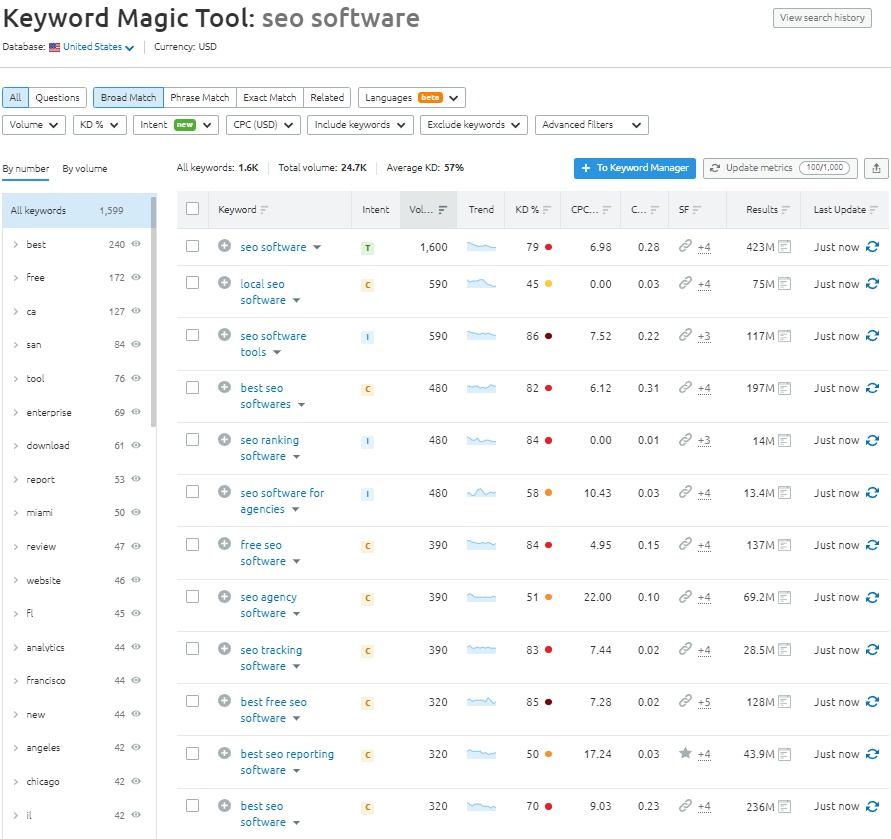
Key Keyword Insights Provided by Both Tools:
- Monthly search volume estimates
- Keyword difficulty scores (called KEI in SE Ranking)
- CPC estimates and PPC competition levels for Google Ads
- Total URL results on SERPs for each keyword
- Unique SERP features for each keyword
- Keyword manager tools let you organize, filter, and save lists
Both Semrush and SE Ranking provide comprehensive tools for researching and analyzing keywords used in Google’s organic and paid search. However, Semrush has a larger keyword database (20 billion vs. SE Ranking’s 7 billion) and more features for extensive keyword research.
Interface Comparison
- Semrush: The Keyword Magic Tool has a streamlined layout with a small trend visual beside each keyword, helping users prioritize keywords based on demand. Clicking on a keyword reveals global volume, related keywords, and top SERP results, making it easier to develop a keyword strategy.
- SE Ranking: SE Ranking’s interface is intuitive, displaying keyword difficulty prominently for quick assessments of competitiveness. Users can view top organic SERP listings, traffic estimates, and keyword rankings all in one place, making it convenient for at-a-glance insights.
Verdict
Whether you choose SE Ranking or Semrush, both SEO tools offer robust keyword research tools suited to different user needs and budgets.
- SE Ranking: An excellent choice for those looking for essential keyword insights in a cost-effective and user-friendly tool. Its interface and presentation of key metrics make it a compelling option for users with a limited budget or simpler SEO needs.
- Semrush: The clear winner for advanced keyword research due to its larger database, trend visuals, keyword gap analysis, and bulk keyword features. These tools offer deeper insights, making it ideal for users who need comprehensive keyword analysis and have a larger budget.
Ultimately, the choice between SE Ranking vs Semrush will depend on your specific needs and budget. Semrush offers more in-depth features, while SE Ranking provides nearly as much value at a more affordable price point.
Rank Tracking
Both SE Ranking and Semrush offer reliable rank tracking tools to help monitor and optimize your website's search engine performance. These tools share several core features, including:
- Tracking rankings on mobile and desktop devices
- Side-by-side comparison of ranking changes
- Daily tracking updates
- Competitor rank tracking
- SERP history for keywords
- Tagging and filtering options
- Traffic and visibility metrics
- Search volume data
- Search intent analysis
- SERP feature tracking
Key Differences in Rank Tracking
A major difference between SE Ranking and Semrush’s rank tracking tools lies in the range of supported search engines. Semrush primarily focuses on Google and Baidu, while SE Ranking expands its capabilities to include Google, YouTube, Bing, Yahoo, and Yandex, making it more versatile for tracking across multiple platforms.
Both platforms also offer search intent analysis, allowing users to determine whether a keyword is informational, navigational, or transactional. This helps SEO pros refine their tracking strategies by focusing on the most relevant queries for their target audience. Semrush integrates intent categorization directly into its keyword tools, while SE Ranking provides intent insights alongside ranking trends for better contextual analysis.
SE Ranking’s Rank Tracker
SE Ranking’s rank tracker provides an organized overview dashboard, with options to group keywords into folders for easy management. A standout feature is the color-coded “dynamics” column, which highlights ranking changes, allowing users to quickly assess keyword performance and identify trends.
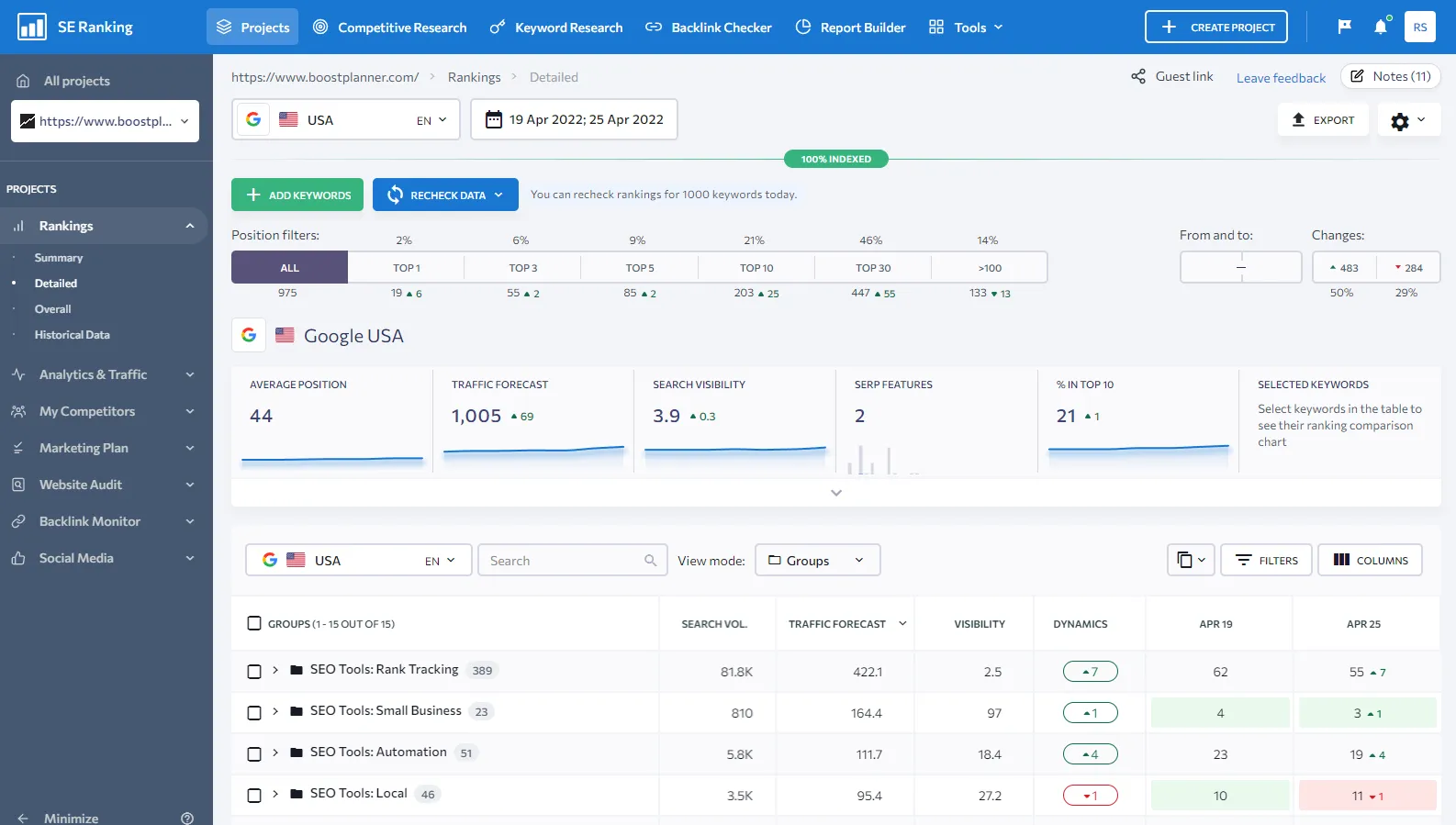
Semrush’s Position Tracker
Semrush’s rank tracker interface is user-friendly, with a clear layout that allows you to easily monitor keyword trends and view distribution across different ranking ranges. The interface is designed for continuous optimization, providing quick access to search visibility changes and helping users stay updated on keyword performance.
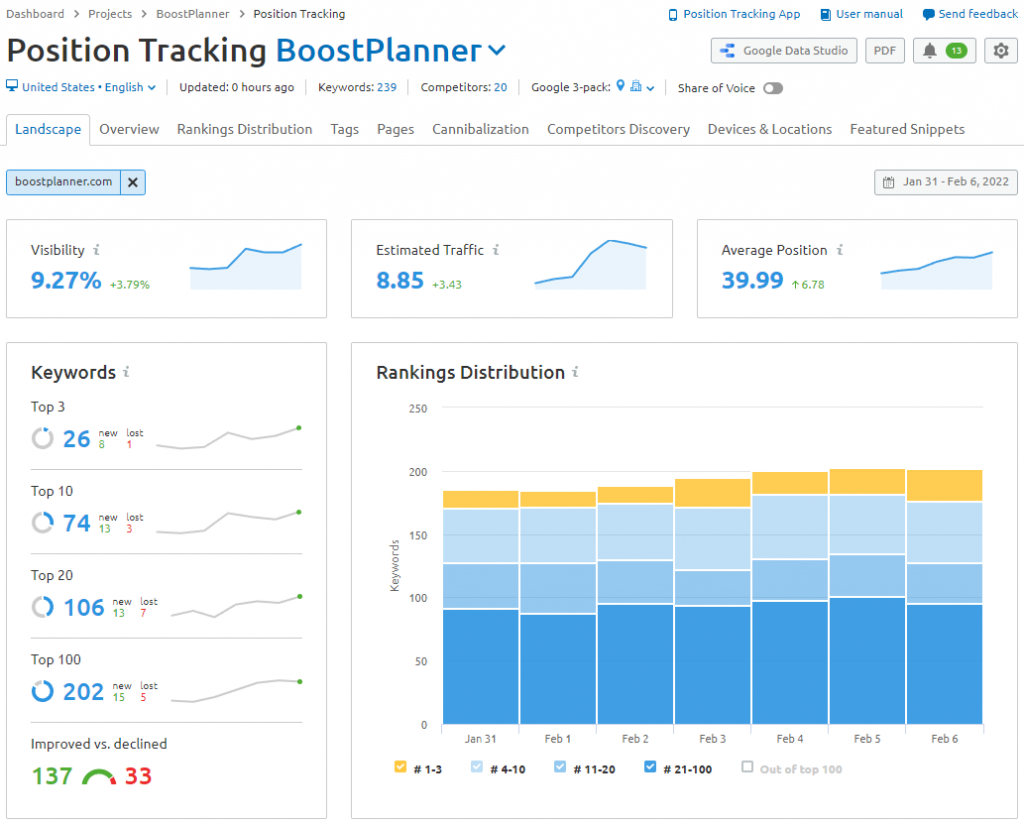
Verdict
While SE Ranking’s folder organization and tagging options enhance keyword management, Semrush’s Position Tracker is particularly effective for quickly scanning ranking trends and search visibility shifts. However, SE Ranking’s broader search engine support (including YouTube, Bing, Yahoo, and Yandex) can be a decisive factor for users who need to track beyond Google and Baidu.
With Google accounting for the majority of search traffic, both SE Ranking and Semrush provide excellent rank-tracking capabilities for most users. Ultimately, the best choice depends on your specific needs, preferred search engine focus, and desired interface style.
Competitor Research
Competitive insights are crucial for any SEO platform, and both SE Ranking and Semrush provide robust tools for analyzing competitors. Here’s how they compare:
Shared Competitor Research Features
Both SE Ranking and Semrush offer comprehensive competitor insights, including:
- Domain authority scores
- Organic search traffic and keywords
- Top-ranking keywords and pages
- Paid search traffic data
- Backlink profiles and analysis
- Historical data (varies by plan)
Key Differences in Competitor Insights
Data Depth and Historical Range
Semrush provides a more extensive dataset than SE Ranking, with historical data available as far back as 2012 in the mid-tier Guru plan. SE Ranking, meanwhile, includes three months of historical data in its entry-level plans and offers unlimited history access on higher-tier plans, providing flexibility for budget-conscious users.
Interface and Usability
SE Ranking: Offers similar domain insights but with a simpler, more streamlined interface that some users may find more accessible. The sidebar navigation in SE Ranking makes it easy to drill down into specific data, presenting a cleaner view of competitor metrics.
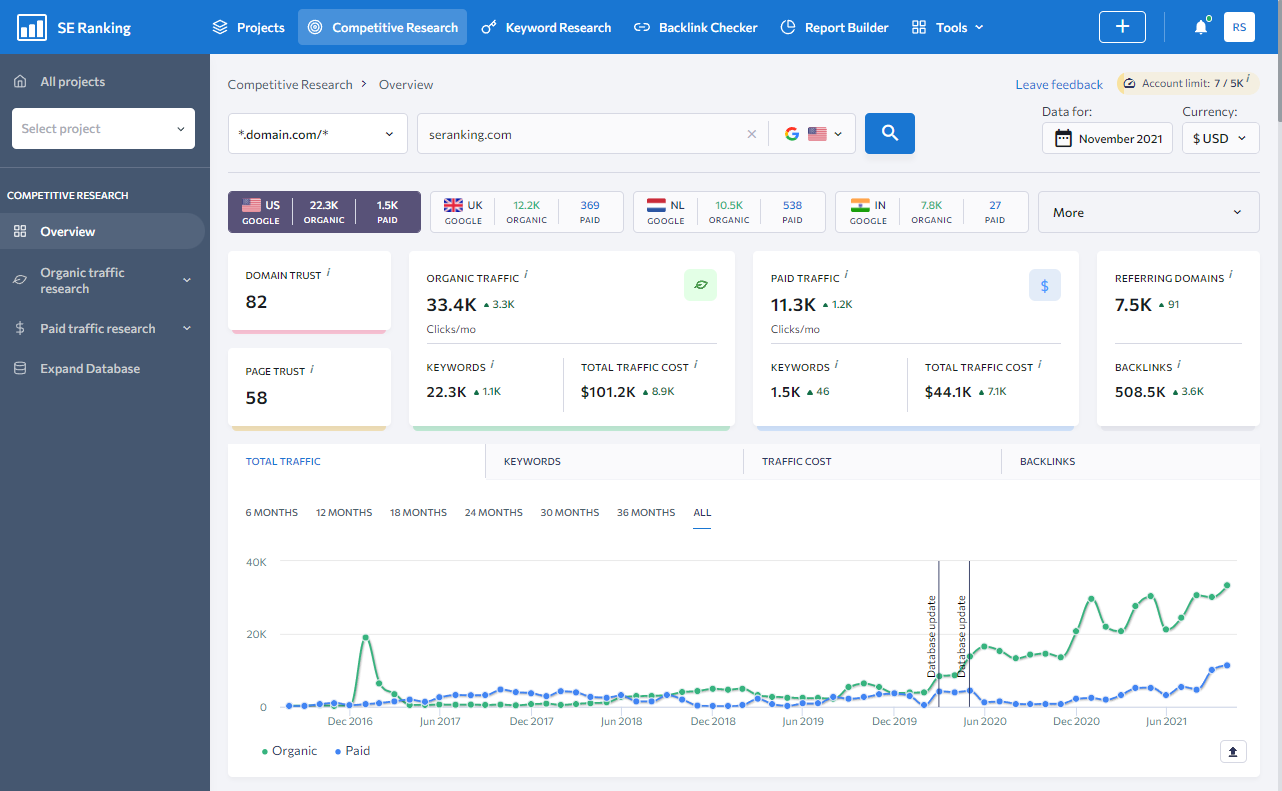
Semrush: Displays high-level domain metrics that link to detailed reports on authority scores, organic and paid search traffic, backlinks, display ads, and keywords. While some users may find Semrush’s interface dense, its depth of data is unmatched once you get accustomed to it.
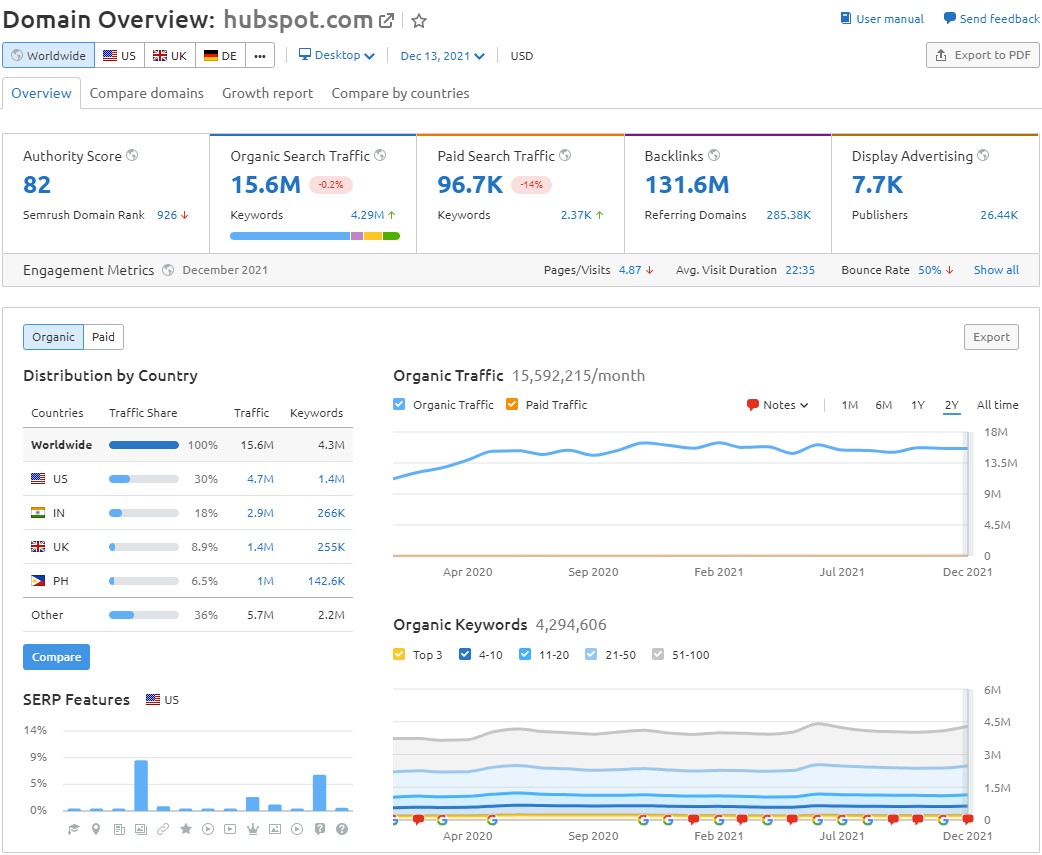
Verdict
Both SE Ranking and Semrush provide valuable competitor analysis and paid traffic research features that can help you understand your rivals’ SEO and PPC strategies.
Semrush takes the lead in data depth and variety, especially with additional tools like Traffic Analytics and Market Explorer for broader market insights (available as a $200/month add-on). SE Ranking offers a strong competitor analysis suite at a lower price, with a user-friendly interface that makes essential competitor insights easily accessible.
If you need extensive historical data and granular details, Semrush is ideal. For a cost-effective solution with all the essential competitive insights, SE Ranking is a solid choice.
Backlink Analysis
Both SE Ranking and Semrush offer powerful tools for researching backlinks, providing insights essential for SEO and competitor research. Each platform covers foundational metrics and tracking options that allow users to monitor their backlink profile effectively.
SE Ranking and Semrush both provide essential backlink insights, including:
- Domain and page authority scores
- Individual backlinks and referring domains
- Referring IP addresses
- Link anchor text analysis
- Dofollow and nofollow link categorization
- Link filtering options
- Tracking of new and lost domains and backlinks
- A backlink gap tool or link intersect feature
SE Ranking’s Backlink Tools
SE Ranking’s backlink tools are designed to provide thorough yet accessible insights into your backlink profile. While SE Ranking does not offer advanced tools like a backlink audit or link-building CRM, its backlink checker tool is effective for foundational research and monitoring at a more affordable price.
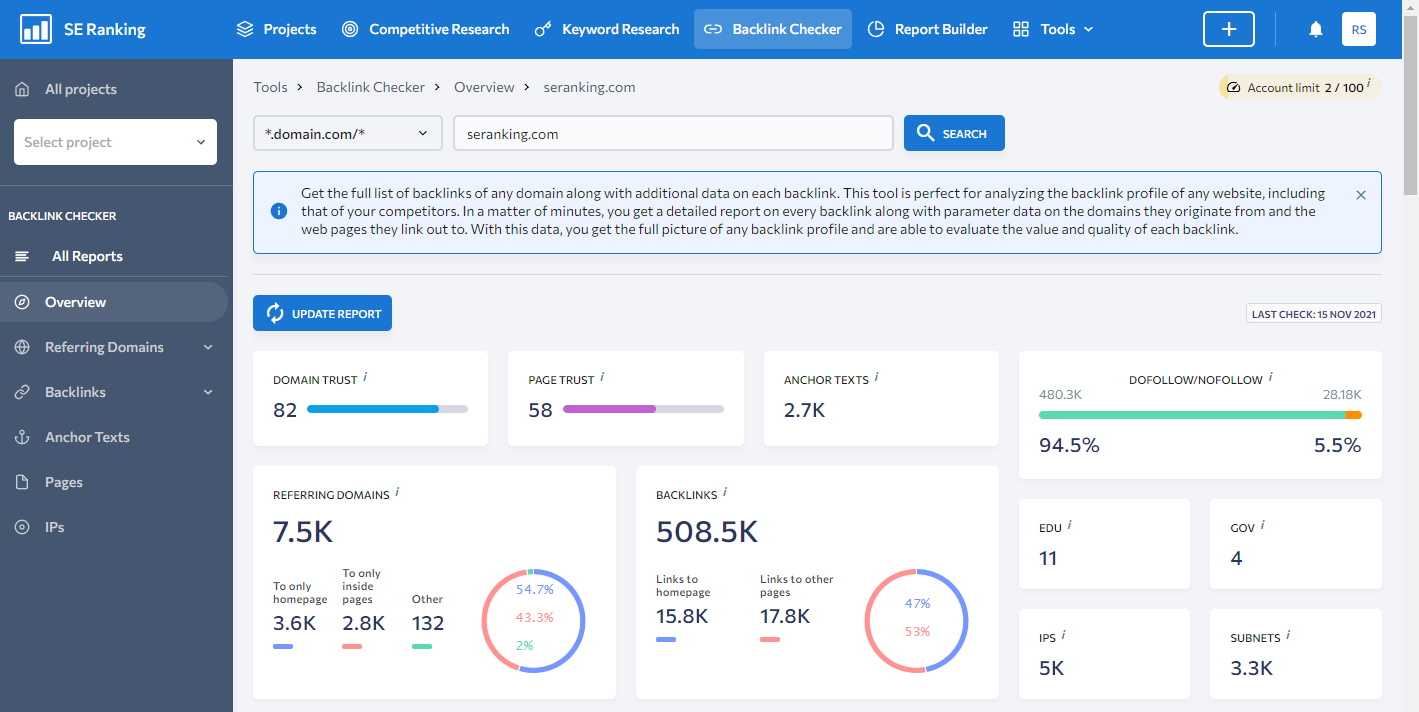
The SE Ranking interface is user-friendly, making it ideal for users who need essential backlink data without additional complexity. It provides critical metrics to track and manage backlinks, including new and lost links, anchor text distribution, and domain authority.
Semrush Backlink Tools
Semrush offers a broader range of backlink analysis tools, including a wide range of features for in-depth backlink management:
Backlink Audit Tool
This feature helps identify potentially harmful backlinks and generate a disavow file for Google, allowing users to manage link toxicity effectively.
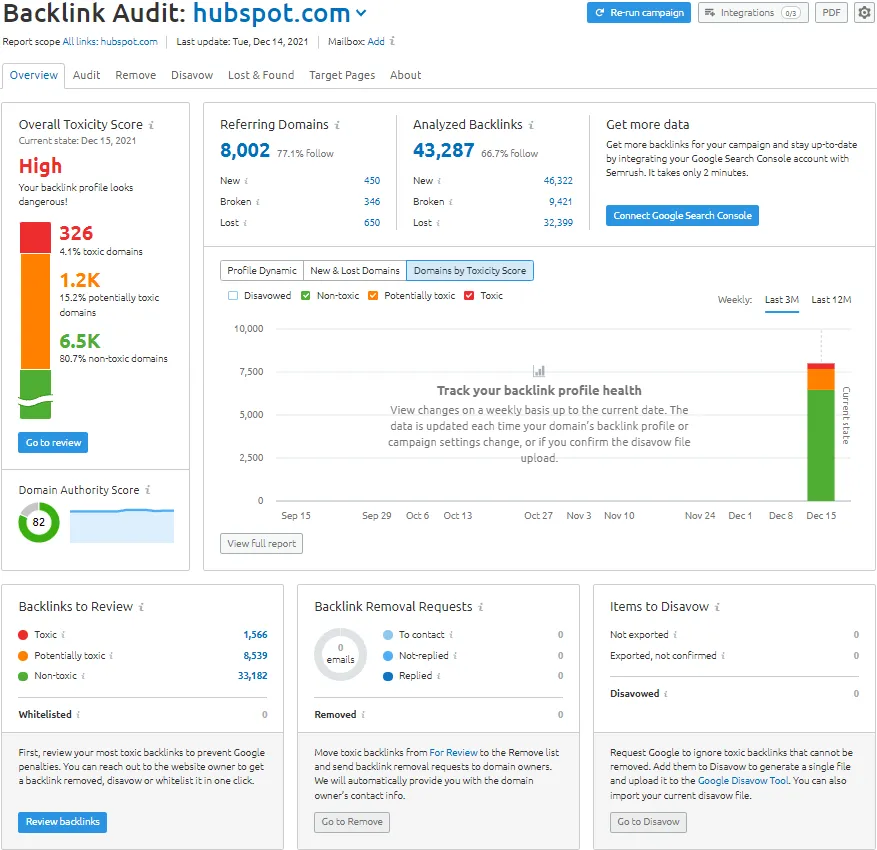
Link Building Tool
Semrush includes a CRM-like backlink tool for managing link outreach campaigns. It integrates with your email, allowing you to create and send outreach emails, customize templates, and track open and reply rates, all within the platform.
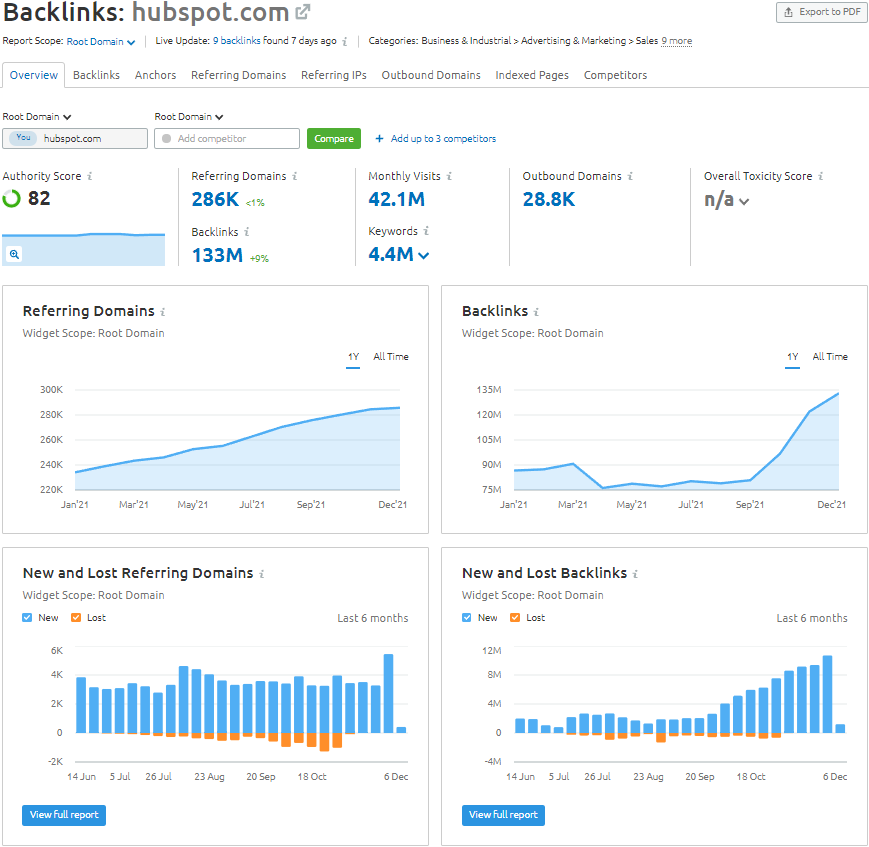
With Semrush's backlink database exceeding 22 trillion links, Semrush offers broader data coverage than SE Ranking, whose database currently includes around 2.7 billion backlinks.
Verdict
Semrush takes the lead in backlink features with its larger database, toxic link audit tool, and integrated link-building CRM, making it ideal for users who need advanced backlink management. SE Ranking, however, provides robust backlink research and monitoring at a lower price, making it a solid choice for users focused on core backlink insights without the added tools.
Site Auditing
Based on this SE Ranking and Semrush analysis of site audit tools, both help you identify and resolve technical and on-site SEO issues affecting your site’s performance. Each tool categorizes potential problems by severity, allowing you to prioritize and address the most critical issues first.
Shared Site Auditing Features
Both SE Ranking and Semrush offer comprehensive site auditing features, allowing you to assess site health across various factors, including:
- Overall site health score
- Duplicate and thin content detection
- Indexing status of crawled pages
- Technical SEO issues like broken backlinks
- Internal and external link structure
- Anchor text usage within internal links
- Missing meta tags, alt tags, and descriptions
- Issue categorization by type and severity
- XML sitemaps and robots.txt file analysis
- Examination of code scripts, CSS, and JavaScript
- Detailed descriptions of issues and recommendations for fixes
- Customizable audit crawl settings
- Scheduled and automated audits for ongoing monitoring
SE Ranking Site Audit Tool
SE Ranking’s website audit tool provides a similar level of depth in technical SEO analysis, with a user-friendly interface that organizes issues by severity and type. SE Ranking’s audit features are particularly accessible for those who prefer a straightforward view of technical issues.
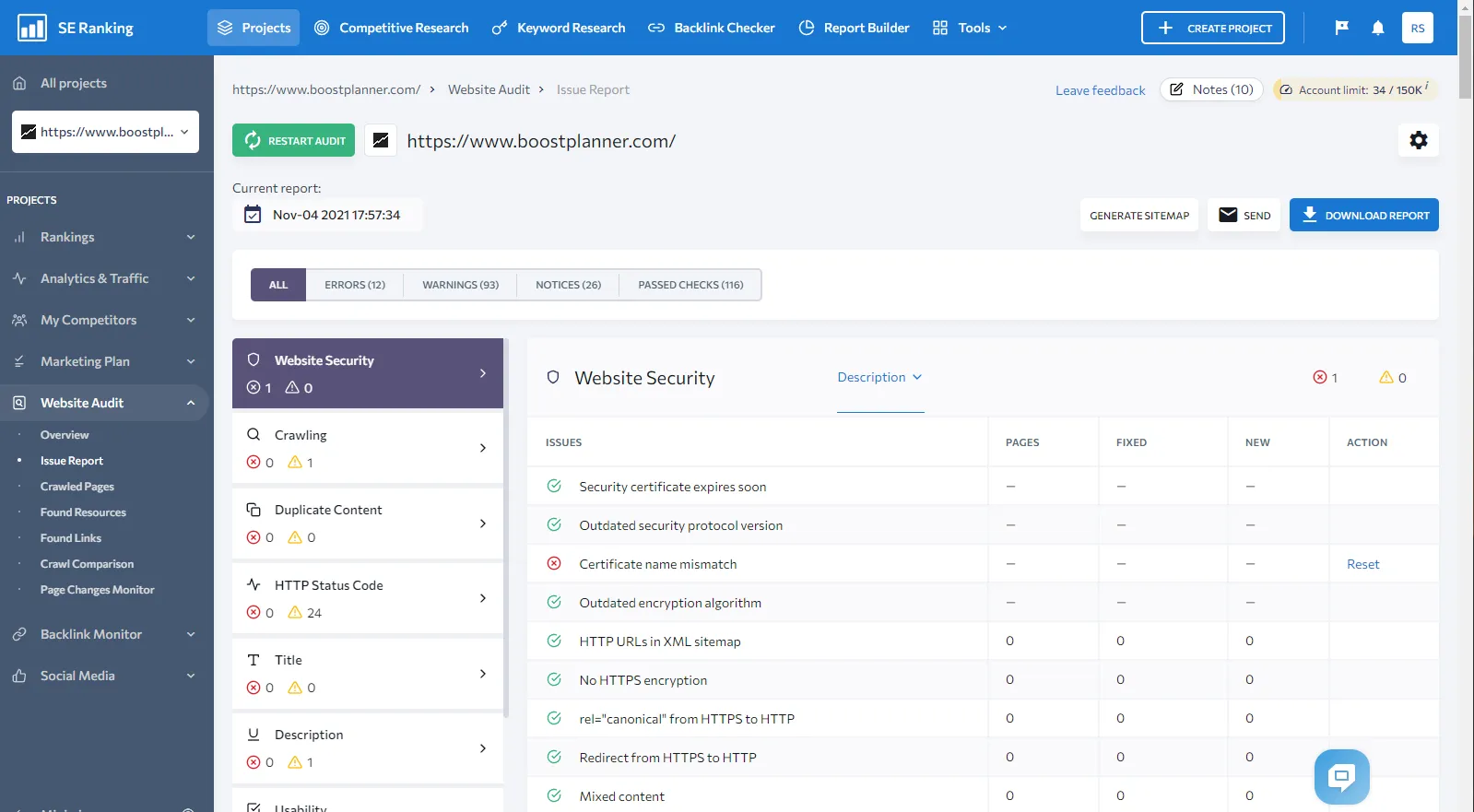
Semrush Site Audit Tool
Semrush offers a more detailed audit in certain areas, providing additional insights on technical and on-page SEO elements. Its comprehensive audit checks cover a broad range of SEO factors, making it particularly useful for more in-depth, large-scale site assessments.
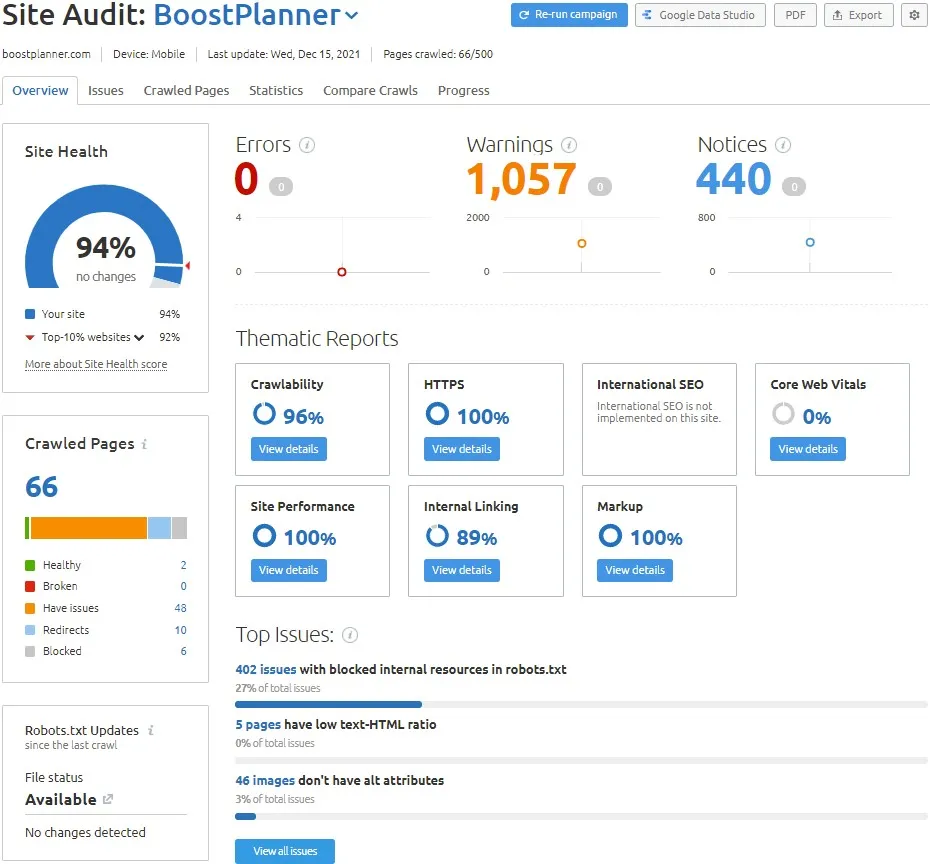
Verdict
Both SE Ranking and Semrush deliver excellent site auditing tools that can help you identify and resolve technical SEO issues across your website. Semrush provides slightly more granular insights, making it better suited for larger sites or users needing in-depth checks. However, SE Ranking offers all essential audit functions in a more streamlined, affordable package, making it ideal for smaller teams or those new to SEO auditing.
On-Page SEO
In comparing SE Ranking and Semrush, both software platforms include powerful tools for analyzing and optimizing on-page SEO. Each platform provides actionable insights that help you refine content, improve technical SEO, and boost online visibility on Google and other search engines.
SE Ranking’s On-Page SEO Checker
SE Ranking's on-page SEO tool offers a comprehensive set of features designed to evaluate and optimize content for targeted keywords. The tool provides an optimization score and organizes insights into categories such as warnings and errors, giving a clear picture of areas for improvement.
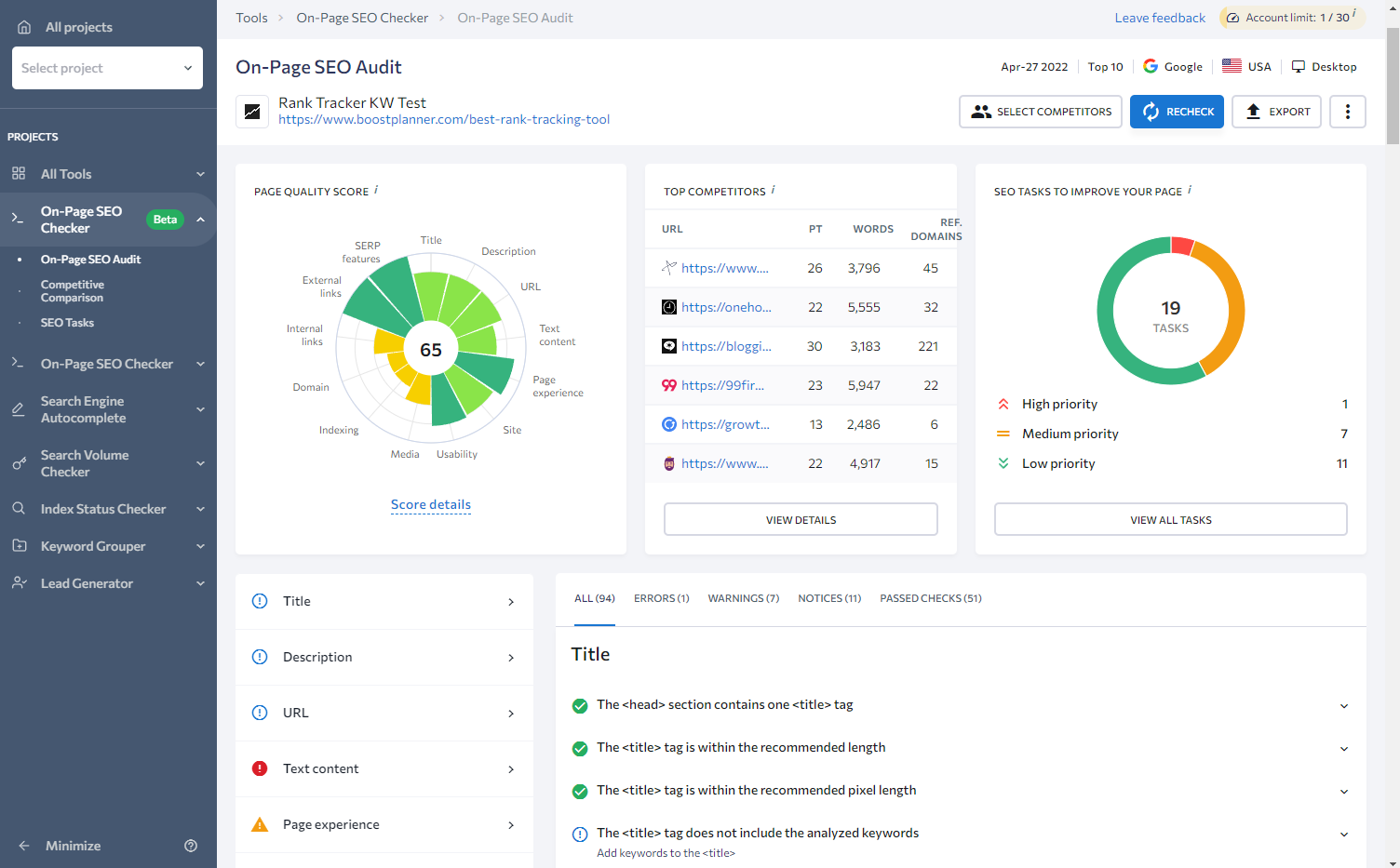
SE Ranking’s on-page checker includes over 80 checks, each categorized by type and severity. This detailed approach covers essential SEO elements, including:
- Titles and descriptions
- URL structure
- Text usage and keyword placement
- Internal linking
- Page speed and mobile-friendliness
Additionally, SE Ranking’s tool is powered by AI-driven content analysis. It adapts recommendations based on top-performing competitors on the Google SERPs, allowing users to adjust content to align with current best practices. SE Ranking also offers a competitive comparison feature, which allows you to compare on-page metrics side-by-side with competing pages, identifying optimization opportunities.
Semrush’s On-Page SEO Checker
Semrush’s on-page SEO checker tool categorizes potential optimization ideas into structured segments:
- Strategy Ideas
- Backlinks Ideas
- Technical SEO Ideas
- User Experience Ideas
- SERP Features Ideas
- Semantic Ideas
- Content Ideas
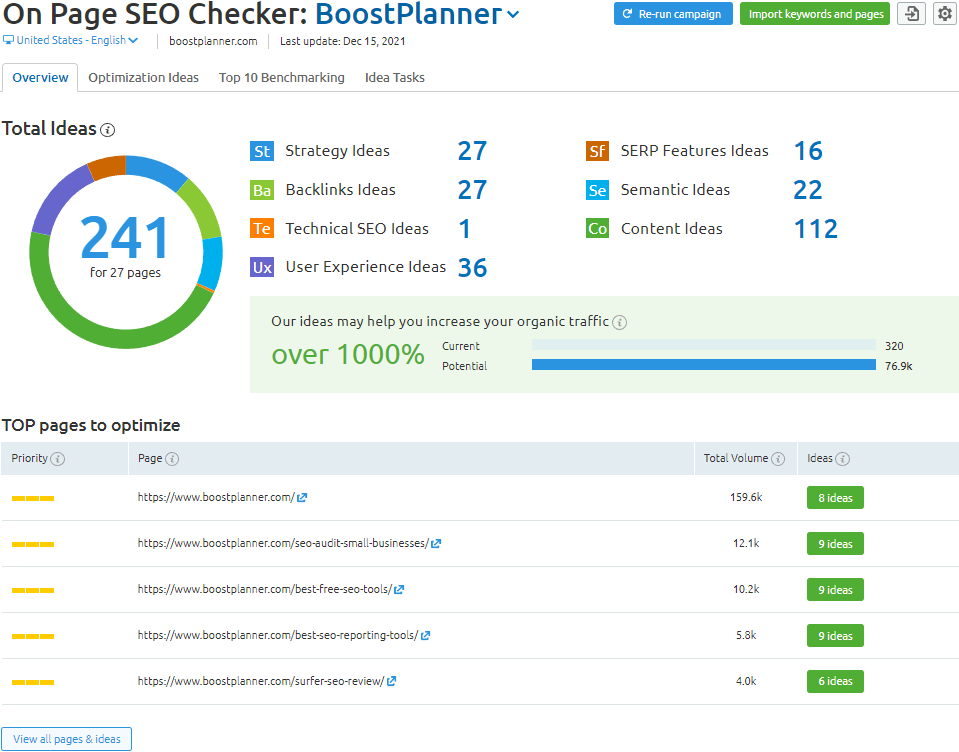
Semrush’s idea-based layout helps prioritize tasks, guiding users toward the most impactful changes. The interface allows users to quickly assess and sort possible optimizations, focusing on enhancements that will drive measurable improvements. This tool provides additional insights into semantic terms and user experience ideas, broadening the scope of on-page SEO optimization.
Verdict
When comparing SE Ranking and Semrush for on-page SEO, Semrush stands out with its deeper segmentation and detailed semantic suggestions, especially valuable if you’re subscribed to the Guru plan. Its structured idea-based layout also makes it easy to identify and implement strategic changes.
However, SE Ranking provides a strong, cost-effective alternative with its AI-driven recommendations, competitive comparisons, and clear categorization of issues. SE Ranking is a solid choice for users seeking core on-page optimization tools without the added complexity of advanced features.
Local SEO
Local SEO is essential for businesses looking to improve their visibility in search results, especially for location-based queries. SE Ranking and Semrush both offer robust local SEO tools, but they have different strengths and approaches.
SE Ranking’s Local SEO Features
SE Ranking provides a comprehensive local marketing platform focused on Google Business Profile (GBP) management, local rankings tracking, and listing management. Key features include:
- Local & Map Rank Tracker – Track Google Maps rankings at a granular, street-level grid view.
- GBP Posts Scheduler – Automate Google Business Profile (GBP) post publishing.
- Listing Management – Sync and update business listings across Google, Facebook, Apple, Bing, and other directories.
- Reviews Management – Collect, analyze, and respond to customer reviews in a unified dashboard.
- Bulk Local Rankings & Grid Rank Tracking – Monitor rankings across multiple locations with a grid-based visualization.
Pricing: SE Ranking's Local Marketing features are available as an add-on for paid users, with pricing based on the number of locations.
Semrush’s Local SEO Features
Semrush’s Local SEO toolkit is designed for business listings, review management, and local rank tracking. Key features include:
- Listing Management – Manage business listings across 150+ directories, including automated duplicate suppression.
- Map Rank Tracker – Track rankings in Google Maps and local packs with ZIP-code precision.
- Review Management – Monitor reviews and use AI-generated responses to streamline customer engagement.
- Position Tracking – Track daily keyword rankings at a hyper-local level.
Pricing: Semrush’s local SEO features are available as a separate paid add-on, with Local Essentials at $50/month per location and Local Advanced at $60/month per location, independent of its main SEO plans.
Verdict: Which Tool Is Better for Local SEO?
- SE Ranking is ideal for businesses needing granular, street-level rank tracking and GBP-focused automation at a more affordable price.
- Semrush is best for businesses needing extensive directory listing management (150+ directories) and AI-powered review management, though at a higher cost.
Both tools offer strong local SEO features, but SE Ranking excels in localized rank tracking, while Semrush provides broader listing and reputation management.
Content Marketing
Both SE Ranking and Semrush offer content marketing tools designed to enhance content creation, research, and optimization. Each platform provides unique features for developing marketable, SEO-friendly content.
SE Ranking’s Content Marketing Toolkit
SE Ranking recently launched a Content Marketing Toolkit as an add-on feature. This toolkit includes an AI-driven content editor that leverages natural language processing (NLP) to provide data-based recommendations. By analyzing top-ranking pages for a target keyword, SE Ranking’s content editor offers:
- Keyword suggestions and placement guidance
- Structured recommendations for headings, paragraphs, and images
- Real-time optimization scoring as content is improved
This toolkit is particularly useful for aligning content with current SERP trends and refining it based on competitive data. SE Ranking’s intuitive layout allows users to quickly see recommended keyword placements and structure, making it a powerful yet affordable solution for SEO-driven content creation.
Semrush’s Content Marketing Platform
Semrush provides a more extensive Content Marketing Platform, available in its mid-tier Guru plan and higher. The platform includes tools that support every phase of content marketing:
- Topic Research: Discover trending topics, subtopics, and content clusters aligned with popular search queries.
- SEO Writing Assistant: Optimize content in real-time for readability, tone of voice, originality, and SEO best practices.
- SEO Content Template: Optimize content for readability, backlinks, and semantically related keywords based on the top 10 ranking pages on Google.
- Page Audits: Review the SEO health of published pages.
- Post Tracking: Monitor the performance of published content.
- Brand Mentions: Track brand mentions across the web.
- Marketing Calendars: Organize content planning and publishing schedules.
- Plagiarism Checks: Ensure content originality and avoid duplicate content issues.
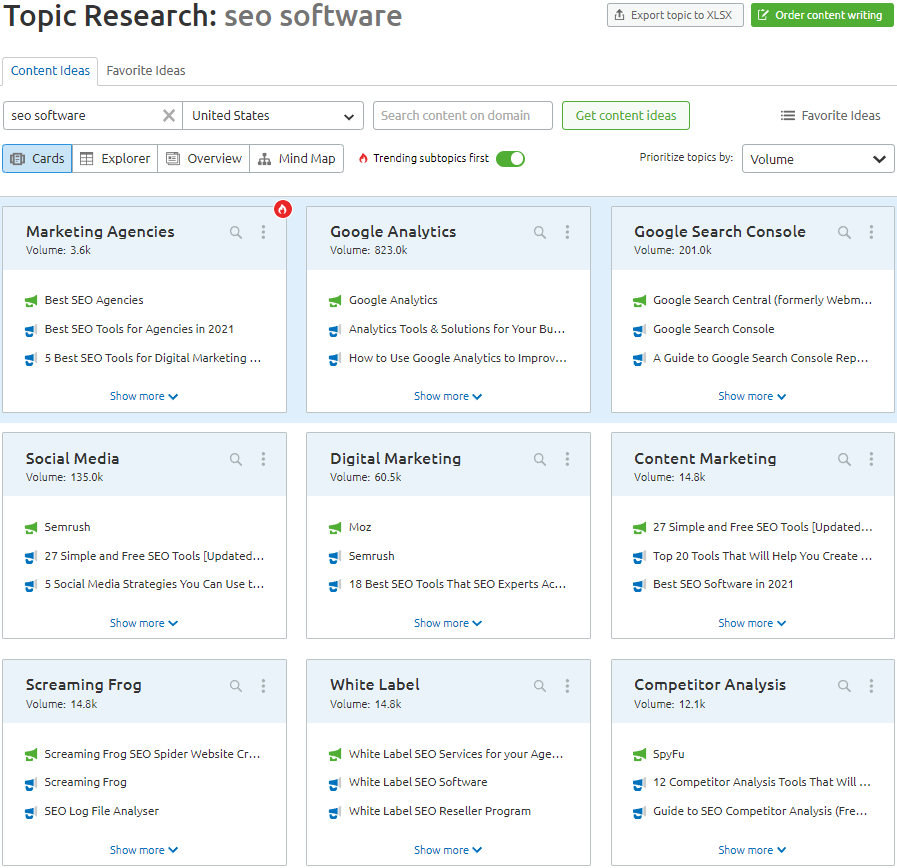
The Topic Research feature is particularly valuable for discovering relevant content ideas, allowing users to identify trending subtopics and keyword clusters.
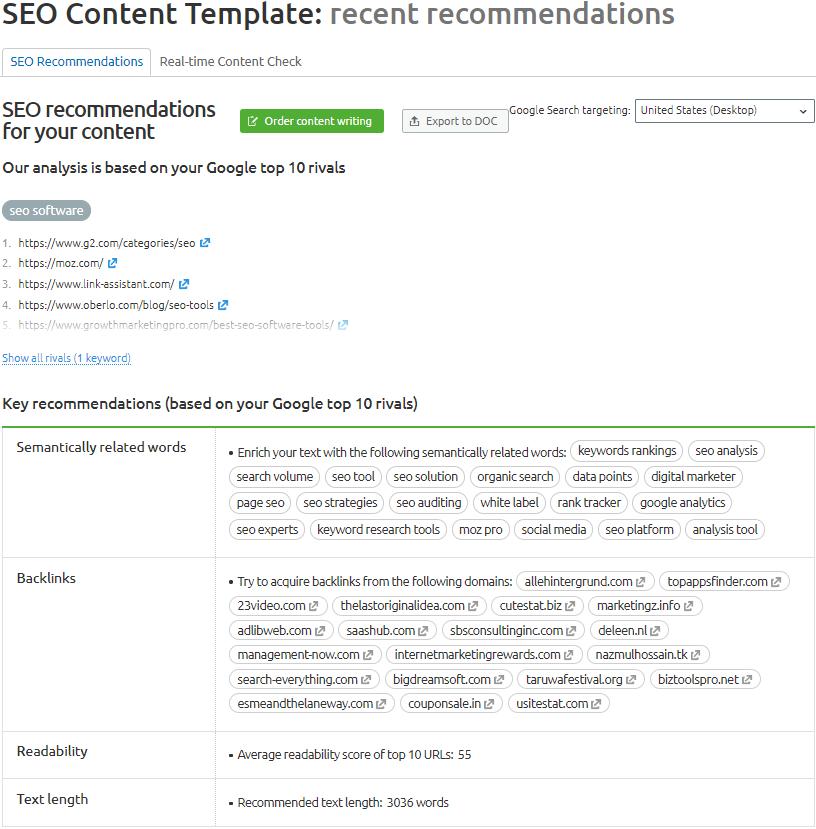
The SEO Content Template offers detailed guidelines on how to optimize content for specific keywords, including insights into readability, related keywords, and backlink opportunities, all drawn from top-performing pages in the SERPs.
In addition to SEO content tools, Semrush integrates social media tracking, auto-posting capabilities, and brand monitoring, providing a comprehensive approach to content and social media management. Supported platforms include Facebook, Instagram, Twitter, and Pinterest.
Verdict
While Semrush provides a few more tools related to content marketing, SE Ranking has introduced a compelling content editor that uses NLP-based keyword suggestions and structural recommendations at a more accessible price point.
Semrush is ideal for users interested in a more complete content marketing solution with integrated planning and tracking. On the other hand, SE Ranking is a practical choice for those seeking essential content optimization features without the additional cost of a full content platform.
AI Writing
When it comes to AI-powered content creation, both SE Ranking and Semrush offer solutions, but their approaches differ significantly. SE Ranking includes an AI Writer as part of its Pro plan, while Semrush provides an AI Writing Assistant as a separate paid app.
SE Ranking’s AI Writer
SE Ranking’s AI-powered content tool is integrated into its Pro plan, offering:
- SEO-focused content generation with built-in competitor analysis.
- Content briefs and outlines based on SERP data.
- Google Docs integration for seamless workflow.
- Word count limits that can be expanded with add-ons.
Semrush’s AI Writing Assistant
Semrush’s AI Writing Assistant is a standalone app that requires an additional $25/month subscription. It specializes in:
- Generating content across multiple formats (blogs, ads, emails, social media).
- Plagiarism detection to ensure originality.
- Support for 25+ languages.
- 75+ AI tools to help optimize tone, structure, and readability.
Verdict: Which AI Writing Tool is Better?
- If you need an SEO-integrated AI writing tool, SE Ranking is a cost-effective option, especially since it’s included in its Pro plan.
- If you want more content versatility (social media, ads, emails) and plagiarism detection, Semrush’s AI Writing Assistant is a stronger option, though it requires an additional subscription.
Ultimately, SE Ranking’s AI Writer is better suited for SEO-driven content, while Semrush’s AI Writing Assistant offers broader content generation capabilities for various marketing needs.
SEO Reporting
Flexible and customizable reporting is a valuable feature in any SEO platform. Both SE Ranking and Semrush offer powerful tools for building SEO reports tailored to various needs.
SE Ranking’s Reporting Tools
SE Ranking provides a drag-and-drop report builder that allows users to assemble reports with ease. Key reporting features include:
- Customizable Report Layouts: Drag widgets into the report from the left-hand display panel for a streamlined setup.
- Essential SEO Data: Cover all key SEO metrics, including rankings, competitor analysis, audits, and backlink monitoring.
- Automatic Scheduling: Schedule reports to be generated and sent automatically, making it easy to keep stakeholders updated.
- White-Label Reports: Create professional, branded PDF reports, which is particularly useful for agencies working with clients.
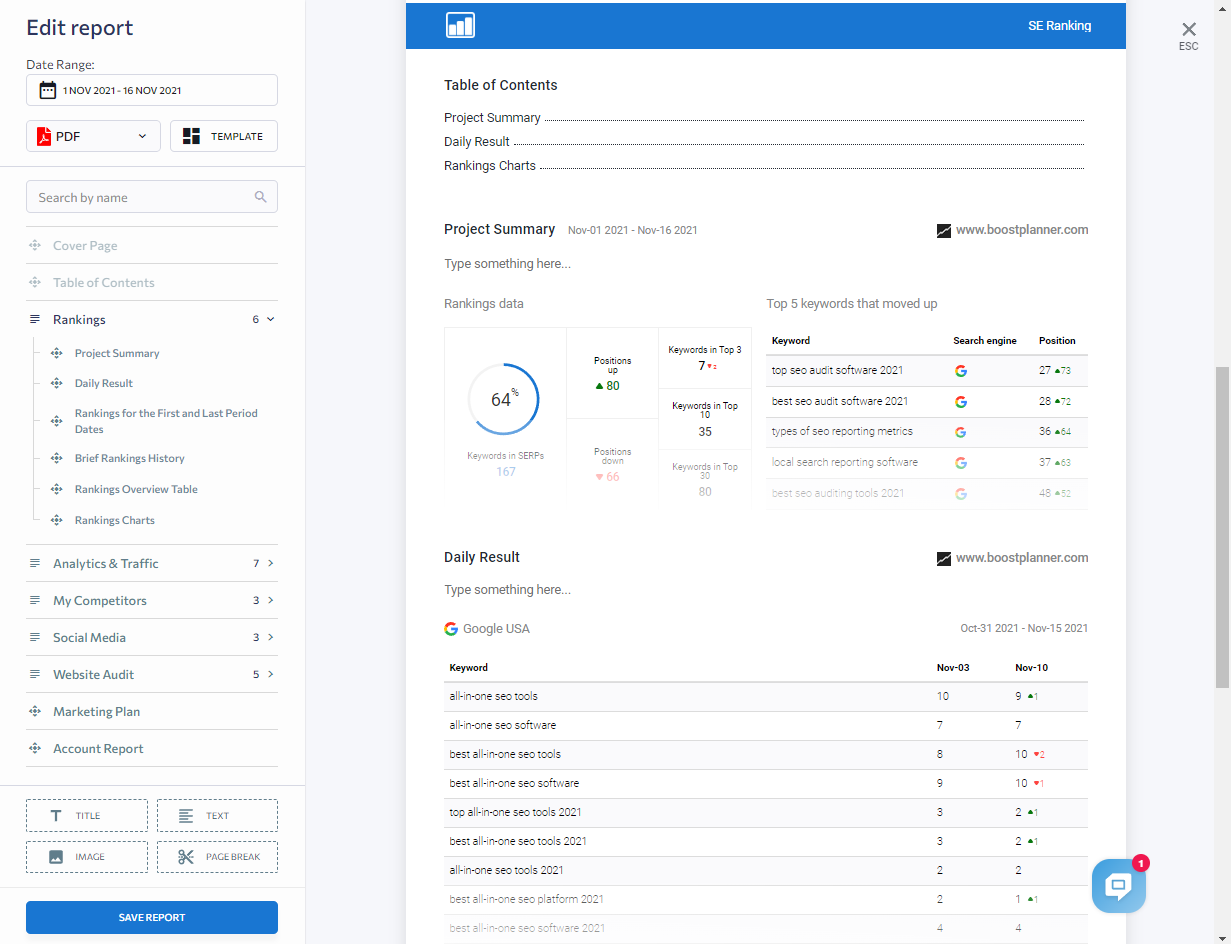
SE Ranking also integrates with Google Analytics and Google Search Console, enabling you to incorporate real-time data into your reports. Although SE Ranking’s reporting features focus primarily on essential SEO data, they are robust and user-friendly, making SE Ranking an excellent choice for standard SEO reporting at an affordable price point.
Semrush’s Reporting Tools
Semrush’s reporting capabilities go beyond basic SEO metrics, leveraging its broader data access and range of features. Highlights include:
- Extensive Report Widgets: Choose from a wider array of data widgets, allowing for more in-depth reporting across multiple SEO metrics.
- Detailed Customization: The report builder offers flexible layouts, with widgets available from the left-hand sidebar, enabling you to customize reports for different audiences.
- Comprehensive Data: Due to Semrush’s extensive data, you can report on a wide range of metrics beyond SEO, including content performance, advertising insights, and social media data.
- Automatic Scheduling and White Labeling: Set reports to auto-generate and apply white-label branding for client-facing documents.
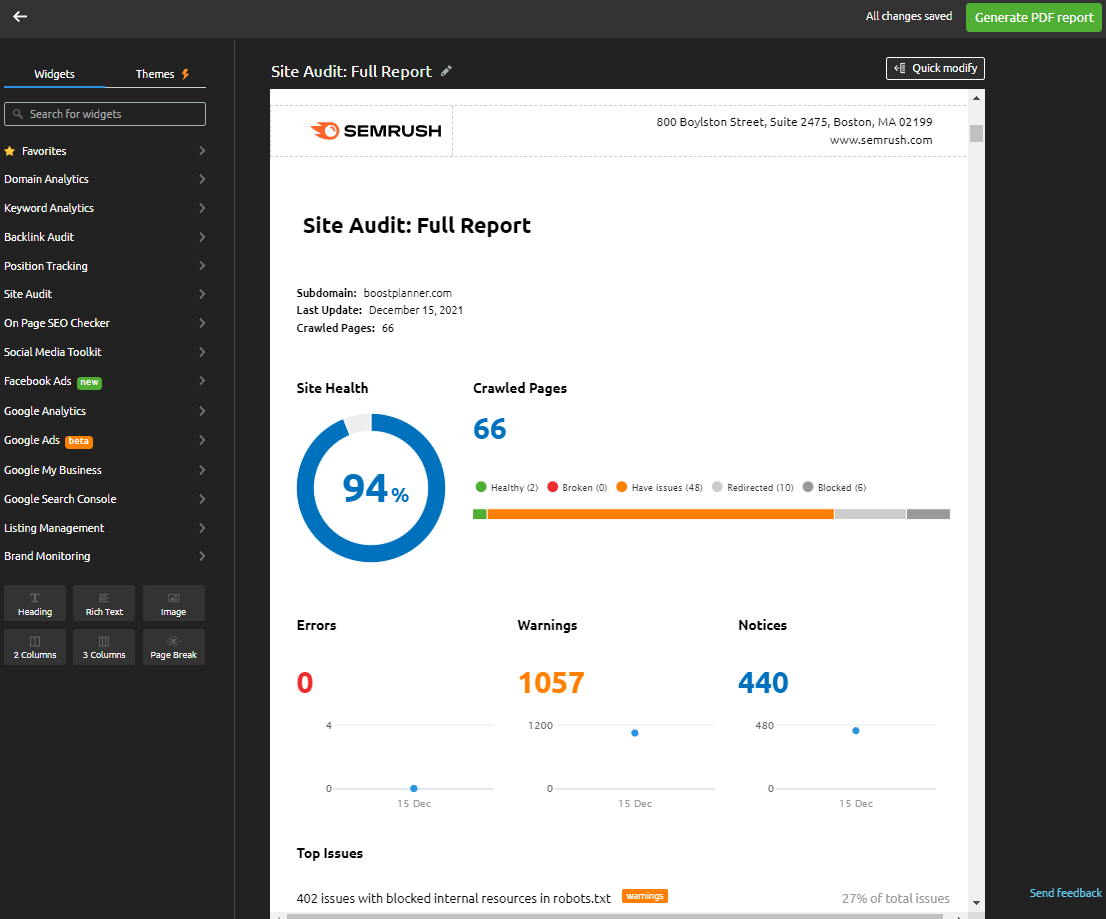
Additionally, Semrush integrates with Google Analytics, Google Search Console, and Google Data Studio (available on the Guru plan and above) for enhanced reporting flexibility and data import options.
Verdict
Both SE Ranking and Semrush offer reliable, customizable reporting options suitable for tracking and communicating SEO performance.
SE Ranking’s reporting tools are straightforward and ideal for essential SEO insights, while Semrush stands out for users requiring more in-depth, multi-dimensional reports across SEO and digital marketing metrics. Semrush’s broader reporting capabilities make it especially useful for agencies and larger teams managing comprehensive campaigns.
Customer Support
In terms of support for customers, both Semrush and SE Ranking provide accessible, knowledgeable support, along with free demos and onboarding assistance to help new users get started.
Each SEO solution offers three main support channels: chat, email, and phone.
SE Ranking’s support options can be easily accessed through its contact page, where users can reach out via a message form. Semrush, on the other hand, prominently lists its phone number, email address, and a chat option in the lower-right corner of its website, making it easy to connect with support directly.
Both platforms also offer extensive online resources, including detailed guides, tutorials, and documentation, making it easier for beginner SEOs and digital marketers to get acquainted with their tools. Semrush goes a step further with Semrush Academy, which offers free online courses covering a range of digital marketing topics for users who want to deepen their SEO knowledge.
Pricing Plans
Let’s take a closer look at the pricing structures for SE Ranking and Semrush, with current rates outlined below.
SE Ranking Plans
- Essential: $65 per month — Ideal for SEO professionals and consultants.
- Pro: $119 per month — Best suited for small teams and agencies.
- Business: $259 per month — Designed for SMEs, large businesses, and agencies.
SE Ranking offers a 20% discount on annual subscriptions, along with an option for free data migration from other SEO platforms. They also provide a free 14-day trial of the Essential plan, allowing you to explore the tool’s features before committing. Custom plans are available upon request for users with specific needs.
Semrush Plans
- Pro: $139.95 per month — Suitable for small teams and marketing consultants.
- Guru: $249.95 per month — Designed for agencies and medium-sized businesses.
- Enterprise: Starting at $5,000 per month — Tailored for large agencies and enterprises, with custom enterprise plans also available.
Semrush offers a discount of up to 17% for annual billing and provides a free trial of the Pro or Guru plan.
Verdict
Deciding between Semrush vs SE Ranking ultimately comes down to your budget, needs, and the scale of your projects. Here’s a summary of the core distinctions:
- Semrush: A premium choice with advanced data capabilities, a wide range of features, and top-tier accuracy. It’s well-suited for larger agencies and enterprises handling multiple, complex SEO projects but comes at a higher price point. SMEs and marketing consultants who require deep keyword research, competitor analysis, and advanced reporting tools may find Semrush's extensive database and automation features particularly useful.
- SE Ranking: A cost-effective alternative that covers essential SEO functions with an ample database, making it ideal for small to mid-sized teams, solo entrepreneurs, and businesses looking for solid SEO capabilities without additional complexity. Its flexible pricing and user-friendly interface make it a great fit for those who want affordability without sacrificing functionality.
Both platforms have a learning curve due to their extensive feature sets. Here are some specific plan differences to keep in mind:
- Project Limits: Semrush’s Pro plan supports 5–40 projects based on the chosen tier, while SE Ranking starts with 10 projects and offers unlimited projects in its Pro plan.
- Historical Data: Mid-tier plans on both platforms unlock access to past data.
- Content Marketing: Semrush’s Guru plan is required for content marketing features, while SE Ranking’s content editor is available as an add-on.
- Reporting: Semrush’s Guru plan supports up to 20 scheduled reports per month, while SE Ranking provides unlimited manual and scheduled reports across all plans, with white-label reporting available from the Pro plan onward.
- User Seats: Semrush charges extra per unique user account, while SE Ranking includes 1 seat on the Essential plan, up to 3 seats on Pro, and up to 10 seats on Business.
- API Access: Available on the highest-tier plans on both platforms, ideal for users needing API integration for custom app development.
Recommendation: For the best value, the mid-tier plans on both platforms typically offer comprehensive access to essential features, including past data, expanded reporting, and more generous usage limits.
In short, Semrush is a premium, data-rich tool for users needing in-depth SEO insights, while SE Ranking is a feature-packed, affordable option for core SEO functions. Both are powerful platforms, each with unique strengths.
Alternative SEO Tools
While Semrush and SE Ranking are powerful options, other all-in-one SEO tools might also suit your needs:
- Ahrefs: Known for its extensive backlink database and robust keyword database, Ahrefs is a popular choice for marketers focused on in-depth analysis and insights.
- Moz: A user-friendly platform with a complete suite of tools for researching keywords, site audits, and rank tracking, Moz also offers a supportive community and educational resources.
- SEO PowerSuite: A desktop-based tool package including keyword research, rank tracking, on-page optimization, and backlink analysis, ideal for users who prefer offline functionality.
- Mangools: A collection of user-friendly tools, like KWFinder and SERPWatcher, aimed at making SEO tasks simpler and more accessible.
- GrowthBar: A Chrome extension offering quick access to essential SEO data, including keyword rankings and competitor insights—a great option for marketers seeking a lightweight solution.
- Serpstat: An affordable, data-rich SEO tool for keyword checking, backlink analysis, and rank tracking, suitable for businesses of all sizes.
- Majestic: A powerful tool focused on backlink analysis and link-building strategies, featuring unique metrics like Trust Flow and Citation Flow.
- SpyFu: An SEO and PPC tool specializing in competitor analysis, ideal for marketers looking to surpass competitors in search and advertising.
Final Thoughts: Which SEO Tool to Choose?
Both SE Ranking and Semrush offer comprehensive SEO toolkits with unique strengths. After reviewing these platforms, you should have a clearer sense of which one better fits your needs and budget.
- SE Ranking is an affordable, user-friendly choice for small businesses, marketers, and agencies needing essential search engine optimization tools without added complexity.
- Semrush is the choice for larger enterprises and experienced marketers who require extensive data, automation, and advanced SEO features.
When it comes to choosing Semrush vs SE Ranking, the best SEO tool for you depends on your specific requirements, goals, and budget. Take advantage of the free trials offered by both platforms to see firsthand how each aligns with your marketing strategy.
Investing in a reliable all-in-one SEO platform will be key to driving online success, improving visibility, and staying ahead of the competition in 2025. Happy optimizing!